Relationship Skills
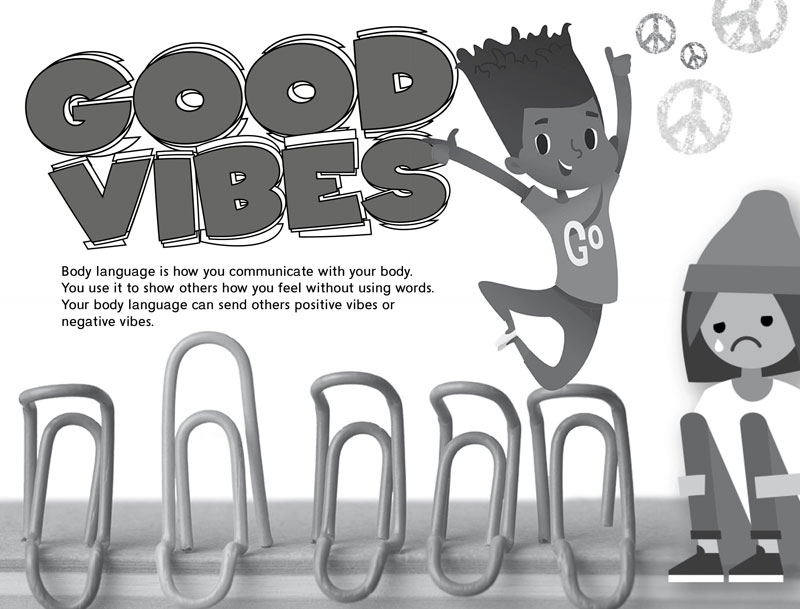
Find this activity in the student portfolio
Objective: Students will be able to use their body language to communicate more effectively.
Estimated Duration: 20 minutes
Description: Body language is a way that people communicate with each other without using words. Your body language sends messages to others about how you are feeling or what you are thinking.
Sometimes your body language sends positive vibes to people and other times it sends negative vibes. Your facial expressions and the way you move your hands, shoulders, and arms gives clues to how you are feeling. Teaching students to be aware of their own body language as well as how to read others’ can help them communicate more effectively.
This activity will help students think about their own body language and the messages it sends to others. They will record examples of positive and negative body language and reflect on the effect it can have on others' feelings.
Teachable Moments: There are many ways you can help students to understand the messages their body language sends.
- Teach children how to take perspective. When a difficult situation arises, help them understand why someone reacted the way they did. What did their body language tell someone else? Did they ignore someone’s body language?
- Help students understand sarcasm and figurative language because sometimes what people are saying does not match what their body is telling us.
- Role play situations where body language plays a key role. Brainstorm situations with students. Write them on index cards and have students take turns acting them out.
- Watch short video clips that show several types of body language. Ask students to explain what the person is feeling and how they know (e.g., clenched fists, fidgeting in seat, arms crossed, etc.)
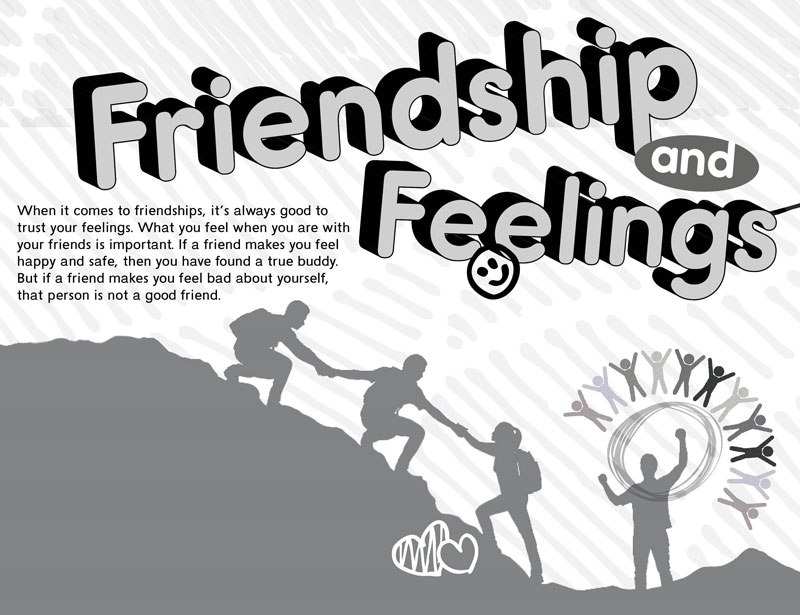
Find this activity in the student portfolio
Objective: Students will be able to understand how to develop healthy relationships.
Estimated Duration: 20 minutes
Description: Friendships have an enormous impact on students' mental health and happiness. The need for belonging is sometimes so strong that negative relationships may result. Too often, students form relationships that are unhealthy, and issues associated with unhealthy relationships can be the cause of any number of problems in the classroom and the school. Teaching students to trust their feelings when it comes to friends will help them develop positive relationships with their peers.
This activity asks students to build a best friend. They will include what qualities they look for in a best friend and how a true friend makes them feel.
Teachable Moments: There are many ways you can help students to develop healthy relationships:
- Help students distinguish between friendly and friend. Students can be friendly to everyone without being friends with everyone.
- Teach students that friendships take time to develop and maintain. Remind them that a true friend is willing to spend time getting to know the other person’s character, likes and dislikes, values, and goals.
- Talk to students about friendship boundaries (togetherness vs. exclusion, fun vs. mean joking, sharing ideas vs. being bossing, etc.). Provide them with examples of behaviors that are okay and not okay. Ask them to share their feelings about each of the examples.
- Play the Top 10 game. Group students who do not typically work together or are already friends. Have them make a Top 10 list of things they have in common.

Find this activity in the student portfolio
Objective: Students will be able to identify ways to resolve conflicts constructively.
Estimated Duration: 20 minutes
Description: Conflicts can cause stress, anger, feelings of resentments, and can make it difficult to focus. Learning skills to help deal with conflict resolution is crucial.
It’s important to teach students how to appropriately manage conflicts to make the situation better and de-escalate moments of high emotions. Conflicts can be difficult to navigate because they bring out big and intense emotions that can be hard for students to process.
One of the best ways to deal with conflict is to talk it out and take turns with the others involved, sharing how each person feels. Students can do this by using I-Statements.
For example, saying I felt sad when you did something, or I felt angry when you did this, and I need you to help me do something in the future, or I need you to speak to me differently in the future.
This activity will have students list the strategies they have used or would like to use to deal with conflict. This will help them when they deal with conflict in the future. Next, students will practice using I-Statements, so they will be prepared when during their next conflict.
Teachable Moments: There are many ways you can help students to resolve conflicts constructively:
- Schedule time for role play. Acting out scenarios involving conflicts will allow students time to practice conflict resolution skills while they are calm and can think clearly.
- Develop students’ listening skills. Sometimes conflicts arise from miscommunication and can be solved simply by listening. Have students focus on making eye contact, paraphrasing back for understanding, and asking questions rather than interrupting.
- Remind students to calm down when their emotions start to rise. They can take deep breaths, go to a designated “chill spot,” listen to music, read books, or do yoga stretches.
- Read stories containing characters that work out conflicts.
- Use conflicts that happen in the classroom as teachable moments.
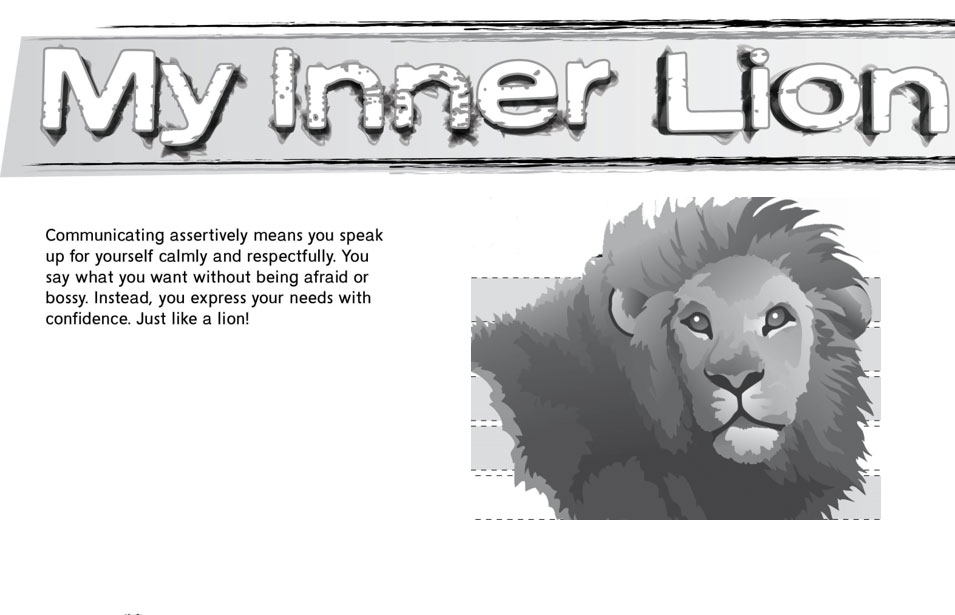
Find this activity in the student portfolio
Objective: Students will be able to recognize and communicate leadership skills in themselves and others.
Estimated Duration: 20 minutes
Description: It is important for students to learn and build on their leadership skills to open new possibilities and help make better decisions. Leadership is a multi-faceted skill that helps students learn to communicate, empathize with others, solve problems, and to work in teams. Leadership skills help you understand yourself, your motivations, and your emotions. As you lead, you learn your values, you create your meaning, and you connect with others.
Good and effective leadership is a skill that can be learned, practiced, and improved on. Most think of the loud and confident personalities as the obvious leaders, but anyone even the quiet, shy kid in class can be a leader. In fact, it is likely that at some point in their life, everyone will be called upon to lead in some way or another. For this reason, it is crucial that we help students learn how to prepare for these leadership roles.
This activity helps students think about how they lead and speak assertively, or with confidence. They are asked to write or cut out words that they can use to speak assertively, to bring out their inner lion!
Teachable Moments: To help students build their leadership skills:
- Be sure to involve students in leadership opportunities in the classroom. Some ideas include handing out papers or leading the line. It is best to make these opportunities become a part of the classroom routine every day.
- Demonstrate how you exhibit leadership skills. Explain what your leadership responsibilities are each day.
- Share good examples of leadership in your community and in the world around you. Discuss the leadership your principal must show. Look for other examples of leadership in coaches, parents, sports stars, movies, etc.
- Provide opportunities for group projects where students can rise to the occasion and lead within a group setting.
- Be sure to involve students in leadership opportunities in the classroom. Some ideas include handing out papers or heading the discussion of a lesson.
- Have students improve the culture at school. Have volunteers step up to lead campaigns to end bullying or raise environmental awareness.
Foldable®: When Moments®
Estimated Duration: 25-30 minutes
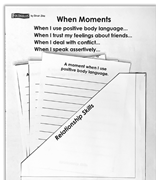
- Cut out the Relationship Skills Pocket and the four Quarter-sheet Cards by cutting along the solid black lines.
- Glue the bottom edge and right edge of the pocket onto the labeled, gray strips in the student booklet. (Note that unlike anchor tabs, pockets have NO folds.)
- Allow glue to dry a minute before placing the Quarter-sheet Cards in the pocket.
- Students write in response to the prompts on each card and store them in the pocket.
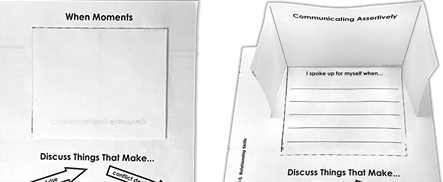
- Cut along the solid black lines of the large Display Foldable entitled Someone I Admire.
- Fold along the three dotted lines of the Foldable. Always fold so the dots are visible along the fold line. On this Foldable, REFOLD each fold again forward and backward so the tabs move both directions. Students might remind each other to refold.
- Under the title, have students draw a picture of someone they admire who communicates assertively. Then, have them write about moments when they (themselves) need to communicate assertively.
- When students are finished drawing and writing on the display, fold in the side tabs and fold the whole display flat into a rectangle. Glue the back of the display onto the large gray rectangle in the student book. NOTE: After it is glued into the student book, the display should fold inward and fold flat so the book can be closed. When the book is open to this page, the display can be opened and folded into a standing diorama.
- When their display is finished, have students talk and write about strategies that make conflict decline.
Go to other SEL competencies in this book (Intermediate - Grades 3–4):

The teaching suggestions only work in accompaniment with the student portfolio, which has all the activity pages.
The teaching suggestions here are also available within a PDF of the entire teacher's manual.
